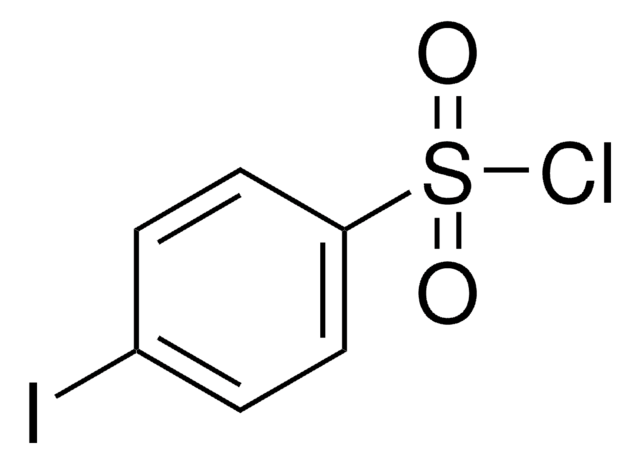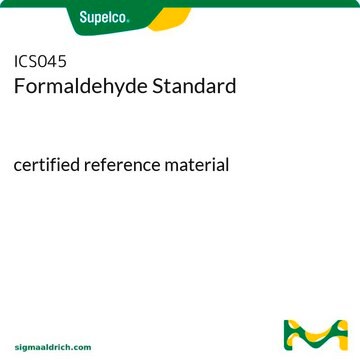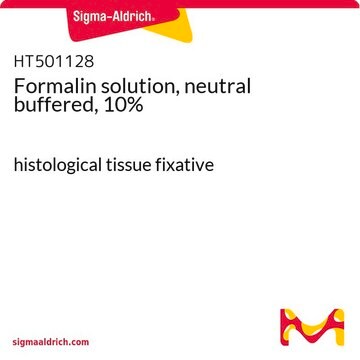If this product has an expiration or retest date, it will be shown on the Certificate of Analysis (COA, CofA). If there is no retest or expiration date listed on the product's COA, we do not have suitable stability data to determine a shelf life. For these products, the only date on the COA will be the release date; a retest, expiration, or use-by-date will not be displayed.
For all products, we recommend handling per defined conditions as printed in our product literature and website product descriptions. We recommend that products should be routinely inspected by customers to ensure they perform as expected.
For products without retest or expiration dates, our standard warranty of 1 year from the date of shipment is applicable.
For more information, please refer to the Product Dating Information document: https://www.sigmaaldrich.com/deepweb/assets/sigmaaldrich/marketing/global/documents/449/386/product-dating-information-mk.pdf
252549
Formaldehído solution
ACS reagent, 37 wt. % in H2O, contains 10-15% Methanol as stabilizer (to prevent polymerization)
Sinónimos:
Formalina
About This Item
Productos recomendados
grado
ACS reagent
Nivel de calidad
densidad de vapor
1.03 (vs air)
presión de vapor
52 mmHg ( 37 °C)
52 mmHg ( 37 °C)
Formulario
liquid
temp. de autoignición
572 °F
contiene
10-15% Methanol as stabilizer (to prevent polymerization)
concentración
36.5-38.0%
37 wt. % in H2O
impurezas
≤0.006 meq/g Titr. acid
residuo de ign.
≤0.005%
color
APHA: ≤10
índice de refracción
n20/D 1.3765
solubilidad
water: soluble
densidad
1.09 g/mL at 25 °C (lit.)
trazas de anión
chloride (Cl-): ≤5 ppm
sulfate (SO42-): ≤0.002%
trazas de catión
Fe: ≤5 ppm
heavy metals: ≤5 ppm (by ICP-OES)
idoneidad
suitable for manufacturing use (Laboratory chemicals)
cadena SMILES
[H]C([H])=O
InChI
1S/CH2O/c1-2/h1H2
Clave InChI
WSFSSNUMVMOOMR-UHFFFAOYSA-N
¿Está buscando productos similares? Visita Guía de comparación de productos
Descripción general
Aplicación
Forma física
también adquirido normalmente con este producto
Palabra de señalización
Danger
Frases de peligro
Consejos de prudencia
Clasificaciones de peligro
Acute Tox. 2 Inhalation - Acute Tox. 3 Dermal - Acute Tox. 3 Oral - Carc. 1B - Eye Dam. 1 - Flam. Liq. 3 - Muta. 2 - Skin Corr. 1B - Skin Sens. 1 - STOT SE 1 - STOT SE 3
Órganos de actuación
Eyes,Central nervous system, Respiratory system
Código de clase de almacenamiento
3 - Flammable liquids
Clase de riesgo para el agua (WGK)
WGK 3
Punto de inflamabilidad (°F)
132.8 °F - closed cup
Punto de inflamabilidad (°C)
56 °C - closed cup
Listados normativos
Los listados normativos se proporcionan para los productos químicos principalmente. Para los productos no químicos sólo se puede proporcionar información limitada. Si no hay ninguna entrada, significa que ninguno de los componentes está en la lista. Es obligación del usuario garantizar el uso seguro y legal del producto.
Elija entre una de las versiones más recientes:
¿Ya tiene este producto?
Encuentre la documentación para los productos que ha comprado recientemente en la Biblioteca de documentos.
Los clientes también vieron
-
How can I determine the shelf life / expiration / retest date of this product?
1 respuesta-
¿Le ha resultado útil?
-
-
How is shipping temperature determined? And how is it related to the product storage temperature?
1 respuesta-
Products may be shipped at a different temperature than the recommended long-term storage temperature. If the product quality is sensitive to short-term exposure to conditions other than the recommended long-term storage, it will be shipped on wet or dry-ice. If the product quality is NOT affected by short-term exposure to conditions other than the recommended long-term storage, it will be shipped at ambient temperature. As shipping routes are configured for minimum transit times, shipping at ambient temperature helps control shipping costs for our customers. For more information, please refer to the Storage and Transport Conditions document: https://www.sigmaaldrich.com/deepweb/assets/sigmaaldrich/marketing/global/documents/316/622/storage-transport-conditions-mk.pdf
¿Le ha resultado útil?
-
-
Can you store formaldehyde in plastic?
1 respuesta-
This product is packaged in glass bottles. Generally, formaldehyde solution can be used in plastic containers. However, it is advised that the unused material be preserved in its original packaging.
¿Le ha resultado útil?
-
-
What type of packaging for different packages?
1 respuesta-
This product is packaged in amber glass bottles with polypropylene caps with HDPE liners. The bottle sizes are as follows:
252549-25 ML in 50 ml bottles
252549-100 ML in 100 ml bottles
252549-500ML in 500 ml bottles
252549-1L in 1L bottles
252549- 4L in 4L bottles¿Le ha resultado útil?
-
-
Can formaldehyde solution 37% be diluted to 10% formalin for fixing cells for staining? Do you dilute it with around 2.7 part water? Thank you!
1 respuesta-
How much water should be added to 100mL of a 37% solution to reduce its strength to a 10% solution?
Use C1 x V1= C2 x V2
37% x 100ml = 10% x V2
Therefore V2 = (37% x 100ml) / 10%
= 370 mLSubtract the total original volume from the new volume.
370 mL - 100 mL = 270 mL
So to reduce 100mL of 37% to 10% solution, add 270 mL of water to 100 mL of Formaldehyde solution - 252549-25ML.¿Le ha resultado útil?
-
-
Which formaldehyde solution is recommended for use with the HT102A Reticulum kit?
1 respuesta-
When a silver stain procedure recommends a 10% formalin solution, it is referring to a 10% aqueous formalin solution, which is prepared by diluting 1 part of 37% to 40% formaldehyde with 9 parts deionized water. For histology, it is advisable to use ACS reagents when the product meets ACS Specifications. Suitable products for this purpose would be product numbers 252549 or FX0410. If a 37% to 40% formaldehyde solution is available, it should work; however, it's important to avoid using old bottles of this solution that have been in the lab for several years, as impurities can form over time. Solutions used in histological procedures should typically be replaced every 2 years to ensure effectiveness.
¿Le ha resultado útil?
-
-
Is the methanol content in the CoA expressed as volume percent or weight percent?
1 respuesta-
The methanol content is expressed as weight percent.
¿Le ha resultado útil?
-
-
Why is Product No. 252549, Formaldehyde solution, stabilized with methanol?
1 respuesta-
The methanol serves to slow the formation of paraformaldehyde.
¿Le ha resultado útil?
-
-
Do you offer 100% formaldehyde instead of solutions like Product No. 252549?
1 respuesta-
Formaldehyde in its pure form is a gas. The maximum concentration of formaldehyde in aqueous solution is about 37% by weight. This is equivalent to an approximately 13.3 M solution.
¿Le ha resultado útil?
-
-
What is a common application for Product No. 252549, Formaldehyde solution?
1 respuesta-
Formaldehyde can be used in multiple applications in different fields. One common application is that this product is a common building block for the synthesis of more complex compounds and materials.
¿Le ha resultado útil?
-
Filtros activos
Nuestro equipo de científicos tiene experiencia en todas las áreas de investigación: Ciencias de la vida, Ciencia de los materiales, Síntesis química, Cromatografía, Analítica y muchas otras.
Póngase en contacto con el Servicio técnico












